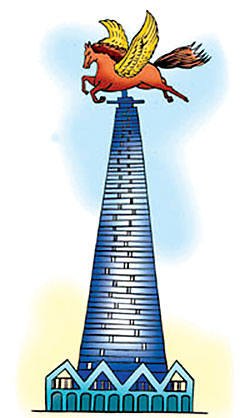 SPACES MAGAZINE |
Prime Minister Madhav Kumar Nepal's plans to erect a Gantantra Stambha, or Republic Tower, appear to be set in the foundation stone he placed on the site recently. I have nothing against commemorating the republic. But it seems the location and dimensions of the proposed monument - meant to symbolise national dignity - are at complete odds with the needs of the public.
Take the location. The erection is going up in the Ratna Park area of Tundikhel. To make the matter even more bizarre, it seems the prime minister is pushing for a tower even taller than Dharhara, with a winged horse on top. Even Don Quixote wouldn't dare dream of such folly.
I do not question the noble intentions of the prime minister and his right to have a personal vision. The problem lies in his prescriptions for a project that is clearly beyond his terms of reference.
It must be very difficult for the legions of Nepali fine artists and architects to swallow the idea that the prime minister is going ahead with his own design concept. This despite the Department of Urban Development and Building Construction's proposal for a design competition. As a professional body and the apex institute in this sector, it should take the appropriate steps, lest it be accused of neglecting its own terms of reference.
But aesthetics aside, it is the site of the proposed monument that is most questionable. For almost four decades now, the open public space of Tundikhel has been abused in the most callous manner. The public has been looking on silently.
We should remember that the whole stretch of Tundikhel, right from Ranipokhari to Dasharath Rangasala (including Army HQ) was conceived as a single physical entity by our visionary ancestors. It was founded as a public domain and a natural endowment as far back as the Malla period, and the state's latest encroachment reveals it to be bereft of ideas. In fact, the prime minister's actions are as bad as the proposed building of a republic monument complex within the Narayanhiti precinct during the tenure of Pushpa Kamal Dahal.
So-called democratic prime ministers appear oblivious to public concerns, which puts me in mind of a conversation I had over two decades ago.
Back then, the late king Birendra had asked me to prepare a master plan for the area around Ranipokhari. I politely but firmly told him that if we really wanted to revitalise the area with its heritage in mind, then it would be necessary to pull down all undesirable structures of Kathmandu's later development, including the Anchaladhish Karyalaya, because they were strangulating Ranipokhari and environmentally bifurcating the total entity of Tundikhel. Cosmetic treatment was not enough, I said.
Point blank the king asked me: did I want to bulldoze all such structures, right from Ranipokhari to Dasharath Rangasala? I replied it was not merely my desire but the right thing to do. To my utter amazement, he took my argument in good sprit and asked me to prepare a comprehensive master plan to protect the whole stretch of the public domain of Tundikhel as a single entity. Political changes, however, prevented this concept from being implemented.
Tundikhel is an open space of tremendous public value. It sets off the manic urban sprawl of the city of Kathmandu. It is the hub of our sociocultural activities. After the 1934 earthquake this is where people sought refuge, and you will understand how significant this open space is. For quite some time now, open spaces such as Tundikhel have come under tremendous pressure in all our cities. They are not just shrinking, but disappearing.
We may be poor in Nepal, but let us not be poor in vision. It is time for us to consider our real needs before we embark on costly mistakes that we may regret later.
"Shrinking Tundikhel" - FROM ISSUE #107 (16 AUG 2002 - 22 AUG 2002)



